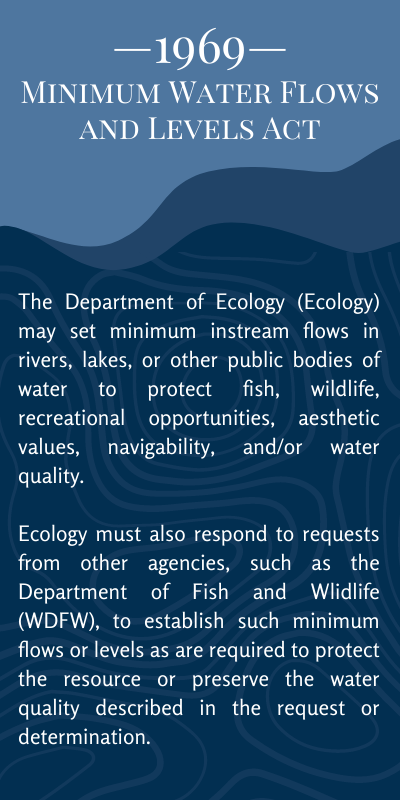Streamflow Protection
Establishing adequate instream flows—essentially a water right granted to the river itself—is one of the best legal tools we have to ensure sustainable water management and build climate resiliency.


Washington’s water resources are over-appropriated.
The state has issued water rights to use more water than can be diverted from streams or pumped from wells and still maintain sustainable ecosystems. Hundreds of streams and rivers are impaired due to lack of flow, and Climate change is making matters even worse as increasing temperatures result in declining snowpack and melting glaciers that provide water in the streams in the summer months when the fish need it the most.
Under statutory programs, the public trust doctrine, and U.S.-Tribal treaties, the State of Washington is obligated,to protect and sustainably manage river flows. Since 1969, state law has explicitly directed state agencies to adopt rules to protect instream flows for public benefit in each watershed. Nonetheless, formal instream flow protections have been adopted for only one-third of Washington’s watersheds.
As climate change shifts the timing and volume of streamflow and reduces snowpack, lower flows during the summer will make it more difficult to maintain an adequate supply of water for communities, agriculture, and fish and wildlife. Preparing for and adapting to the impacts of climate change will require new management approaches that consider how future conditions are likely to change Washington’s water resources. Setting instream flows in the remaining unprotected watersheds would be a critical step to protect stream flows from the impacts of climate change.
Q: How do instream flow rules affect cities and towns?
A: As most cities and towns hold enough water rights to serve many years of future growth, further development in urban and suburban areas is generally unaffected by instream flows. Adopting new instream flows rules will affect those wishing to build homes in rural areas that would rely on a permit-exempt well, and in some areas, may make drilling a new well impossible.
Q: How do I know if I need - or have - a water right?
A: You need a water right if you plan to use any amount of surface water (from a river, stream, spring, or lake) for any purpose unless you fall into one of these categories:
-
- single or group domestic uses of less than 5,000 gallons per day
- industrial uses of less than 5,000 gallons per day
- irrigation of lawn or non-commercial garden, a half-acre or less in size
- stock water
If you receive your water from a utility, you don’t need a water right as long as your provider has the necessary rights.
You can find out more about your rights here or search for your existing water right here.
Q: How will my existing water right be affected by the adoption of an instream flow rule ?
A: It won’t. An instream flow is junior to any pre-existing water rights and can’t affect them. Even if the flow is not being met, water rights that predate the flow rule may use water. In fact, instream flows protect existing water rights because they ensure that the river won’t be further over-allocated.
Q: Are you saying that new water rights will never be given out?
A: No. Establishing instream flows does not mean there is no opportunity to obtain new water rights for projects proposed after the flow rule. Interruptible water rights that are usable whenever flow levels exceed the instream flow can still be issued. There is also always the option to obtain a water right by mitigating use to avoid impacts on the instream flow.
Q: Does my water right guarantee water during a drought?
A: No, you are not guaranteed water. Your water right depends on the health and flow of your water source and the seniority of your water claim.


Instream flows have been set in about half of Washington’s 62 watersheds, but all those in orange desperately need updating. CELP is working to ensure all of our waterways gain this valuable, legal protection based on the best-available, up-to-date science.
Legal Precedent






